X-trader NEWS
Open your markets potential
A look at stablecoin usage around the world from $13 trillion in transactions

# English Translation
Authors: Kate Li & Maria Shen, Electric Capital; Compiled & Translated by: Jinse Finance
## Executive Summary
We analyzed three months of transaction data from wallets holding stablecoins across five major stablecoin networks—Ethereum, Base, BSC (Binance Smart Chain), Tron, and Solana. These networks processed a total of $13.59 trillion in transactions between July and September 2025. By mapping the active times of these stablecoin-holding wallets, we can infer the geographic locations of global users.
Stablecoin usage is truly global, yet its distribution is uneven. Three clear patterns emerge from the data:
1. **Exceptionally high activity in the Americas**
Despite accounting for a relatively small share of the global population, users in the Western Hemisphere generate stablecoin transaction volumes that rival or even surpass those of much more populous regions. This indicates significant growth potential for stablecoins in other parts of the world—particularly in high-population-density regions where adoption remains relatively low.
2. **Different chains serve distinct geographic regions**
BSC and Tron are highly concentrated in markets across Asia, the Middle East, and Africa (AMEA), with minimal activity (<3%) during Western working hours. In contrast, Ethereum, Solana, and Base exhibit broader geographic coverage than BSC and Tron, with active users spread across multiple time zones.
3. **Geographic distribution of large vs. small wallets varies by chain**
Base and Solana show distinct divergence: large wallets (potentially institutional) are concentrated in Western financial hubs, while small wallets (likely retail users) are distributed globally. By comparison, BSC, Tron, and Ethereum display more consistent geographic distribution across wallet sizes, reflecting a more geographically unified user base.
## Important Considerations
### Wallets ≠ Individuals
Each wallet represents an address, not a person. If the number of wallets per capita varies by region, the geographic distribution of the actual population may differ. This analysis assumes that wallet ownership per capita is uniformly distributed globally.
### Geographic Inference Relies on Typical Working Hours
We infer wallet locations based on their activity between 9:00 AM and 5:00 PM local time. However, regional mapping could shift if stablecoin users in certain areas tend to transact outside these hours. While stablecoin activity occurs across all time periods, this analysis assumes early risers and night owls are roughly evenly distributed globally—making the 9 AM–5 PM framework directionally valid for identifying key activity regions.
Our full methodology is available at the end of this report.
## Stablecoin Usage Is Global, but Western Activity Is Disproportionately High
We first aggregated activity across all five chains to identify broad patterns in global stablecoin usage.
Stablecoin activity exhibits two distinct peaks across regional hubs
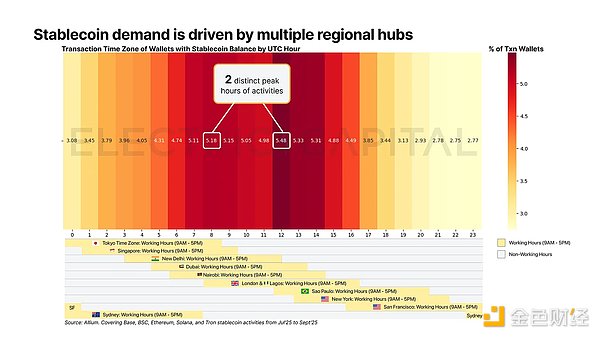
Stablecoin activity is not limited to a single geographic region. Instead, its use is spread across time zones, with two distinct peaks:
8:00 UTC - when working hours overlap in Asia, the Middle East, Africa and parts of Europe
12:00 UTC — When working hours overlap in the Middle East, Africa, Europe, and Latin America (US East Coast joins at 13:00 UTC)
This double-peak pattern suggests that stablecoin demand is driven by a combination of several regional centers, rather than being dominated by a single geographic region.
But the Western Hemisphere’s influence exceeds its population weight
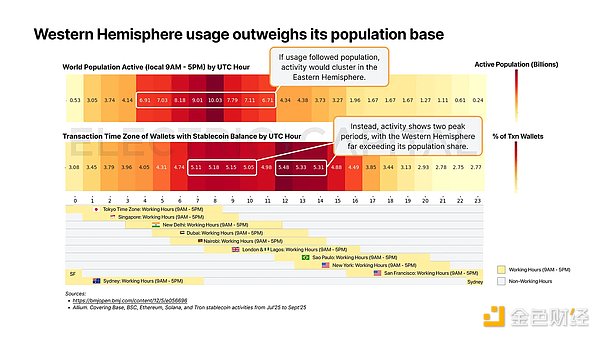
If stablecoin adoption followed population distribution at all, activity would be highly concentrated in the Eastern Hemisphere (UTC 4–11), as the majority of the world’s population lives there (as shown in the chart above).
However, the peak at 12:00 UTC reveals the disproportionate influence of the Western Hemisphere: despite a smaller population base, the Americas generate more stablecoin activity than more densely populated regions.
Large-value wallets are concentrated in financial centers, while small-value wallets are distributed globally
We now segment wallets by stablecoin balance to see if different types of users behave differently. As of October 1, 2025, approximately 0.3% of wallets held more than $100,000, while 80.4% held between $1 and $100. These groups show different geographic patterns.
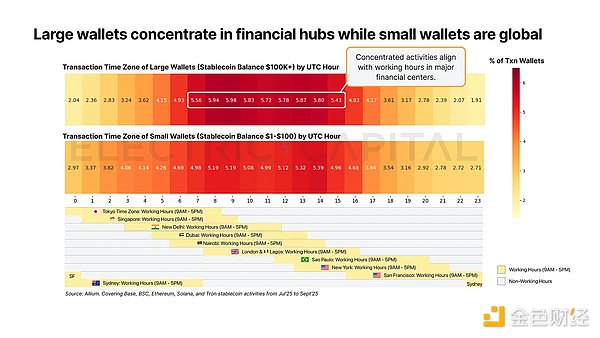
Large wallets cluster around traditional financial centers
Activity from large wallets ($100,000+) is concentrated between 07:00 and 15:00 UTC, which coincides with business hours in Asia, the Middle East, Europe, and the East Coast of the United States. This pattern suggests that institutional or professional users operate primarily during the business hours of major financial centers.
Small wallets show wider global adoption
Small value wallets ($1 to $100) show broader activity across all time zones, without the sharp drop in concentration seen with larger value wallets. This distribution shows that daily users are transacting throughout the day in different geographical areas.
BSC and Tron remain anchored in the Eastern Hemisphere, while Ethereum, Solana, and Base have global reach
Next, we break down stablecoin activity by chain to see if different networks serve different parts of the world. The answer is: some chains have achieved global distribution, while other chains are still concentrated in specific regions.
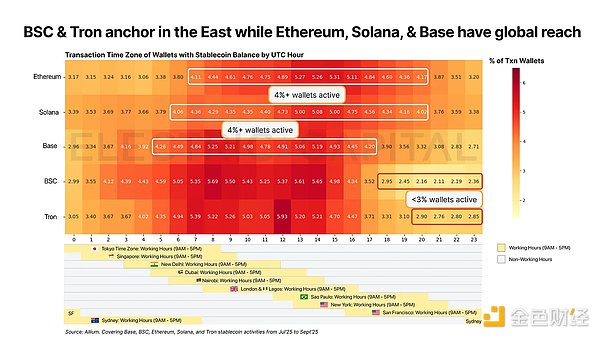
Ethereum and Solana demonstrate balanced global usage
Ethereum and Solana activity is spread across both hemispheres, with strong participation during both Eastern (UTC 7–11) and Western Hemisphere (UTC 13–16) business hours. These chains have successfully penetrated global markets.
BSC and Tron anchored in Asia, Middle East and Africa
BSC and Tron show strikingly similar patterns, with activity concentrated between 06:00 and 15:00 UTC – which coincides with working hours in Asia, the Middle East, and Europe. Although both chains have large total user bases, the share of activity during the US session is less than 3%, indicating extremely low relative adoption in the West.
Base shows emerging global influence
Base exhibits more geographic diversity than BSC or Tron, with significant activity across multiple time zones. While not yet reaching the global balance of Ethereum or Solana, Base is showing strength in the Western Hemisphere while growing adoption in other regions.
On different chains, large wallets and small wallets are aggregated in different ways.
Breaking down activity by chain and wallet size reveals distinct patterns. Large wallets (which may represent institutional or professional users) versus small wallets (which may represent retail users) show different geographic concentration. However, these patterns vary from chain to chain.
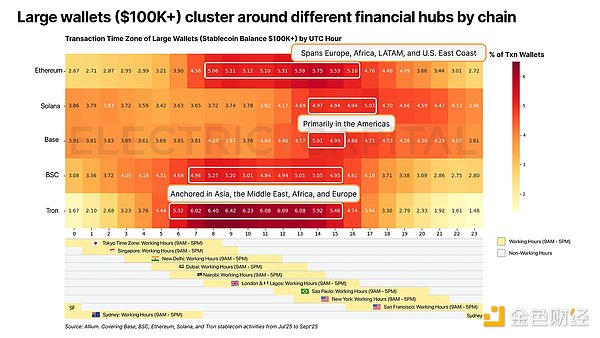
Large value wallets ($100,000+) cluster around different financial centers on different chains
Ethereum: Concentrated between 8:00 and 16:00 UTC, spanning Europe, Africa, Latin America, and the US East Coast – the most geographically diverse of the major chains.
Solana and Base: Mainly active in the Americas, with peaks starting at approximately 13:00 UTC, when US and Latin American markets begin trading.
BSC: Clustered between 07:00 and 15:00 UTC, consistent with working hours in Asia, the Middle East, Africa, and Europe, with minimal US activity.
Tron: The most regionally concentrated, active between 6:00 and 16:00 UTC, anchored in Asia, the Middle East and Africa.
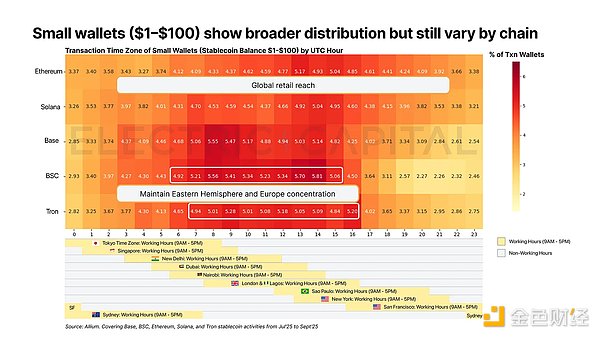
# English Translation
Small Wallets ($1–$100) Have Wider Distribution but Still Vary by Chain
- **Ethereum & Solana**: Demonstrate global retail reach, with strong participation across both the Americas and other regions.
- **BSC & Tron**: Maintain concentration in the Eastern Hemisphere and Europe, indicating retail adoption follows the same geographic patterns as large wallets.
- **Base**: Shows retail strength in the Eastern Hemisphere, while Western Hemisphere participation is emerging.
## In-Depth Analysis: Stablecoin Activity Patterns by Chain
We now examine each chain individually, segmenting activity by wallet size to understand where different types of users operate on each network.
### Ethereum
Ethereum maintains a global distribution, yet its usage in Western regions is disproportionately strong relative to the region’s share of the global population.
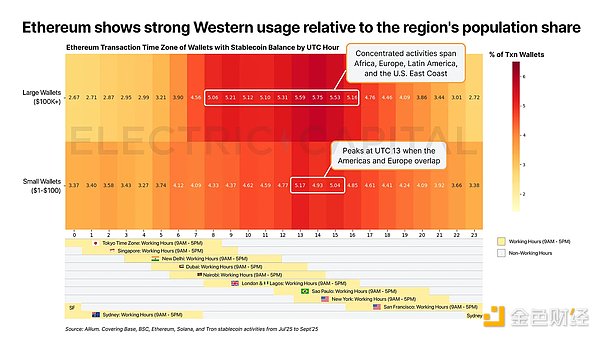
*[Image: pIePA5T99DPN18uhOUi1ObUlXNIRfoC5yUia7EkG.png]*
- **Large Wallets (Over $100,000)**: Activity is concentrated between 8:00 UTC and 16:00 UTC, with peak participation spanning Africa, Europe, Latin America, and the U.S. East Coast.
- **Small Wallets ($1–$100)**: Activity peaks at 13:00 UTC, during the overlapping time window of the Americas and Europe. Despite the smaller population of the Western Hemisphere, its per capita usage significantly exceeds that of other regions.
Ethereum’s user base is global, but Western users—whether holding large or small wallets—participate disproportionately relative to their share of the global population.
### Solana
Solana exhibits a geographic divide between large and small wallets: large funds are concentrated in the Americas, while small wallet users are distributed globally.
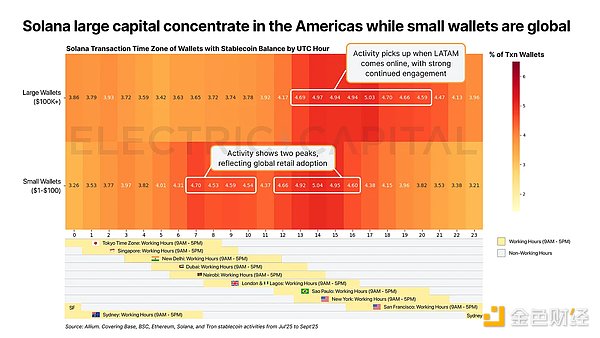
*[Image: Bw6bZNOSAXQoqAazkrP0w03eJLuoQ0TYHaLrIzdE.png]*
- **Large Wallets (Over $100,000)**: Activity begins at 13:00 UTC (when trading starts on the U.S. East Coast and Latin America) and remains strong until 16:00 UTC. Per capita usage on the U.S. West Coast is the highest of any region worldwide.
- **Small Wallets ($1–$100)**: Activity shows two peaks—7:00–10:00 UTC (overlap of Asia/Middle East/Africa/Europe) and 12:00–16:00 UTC (overlap of Europe/Latin America/North America)—reflecting global retail adoption.
Solana has a clear institutional-retail geographic gap: large wallets cluster in Western financial hubs, while small wallets transact across all time zones.
### Base
Base has the sharpest geographic divide between large and small wallets: small wallets skew toward the East, large wallets skew toward the West, and large wallets have a broader activity distribution than small ones.
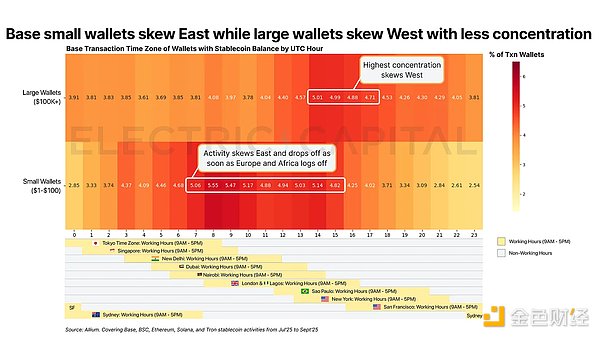
*[Image: iBvxDPZVN6RkmoGyoOxakVitoIvZOzt3ivZzkfbE.png]*
- **Large Wallets**: The most concentrated period is 14:00 UTC, during the overlapping time window of Europe, Africa, Latin America, and the U.S. East Coast.
- **Small Wallets**: Follow the general cross-chain trend but skew more heavily toward the East. Usage drops sharply once users in Europe and Africa go offline.
### BSC
BSC is anchored by users in the Eastern Hemisphere, with limited activity during U.S. hours.
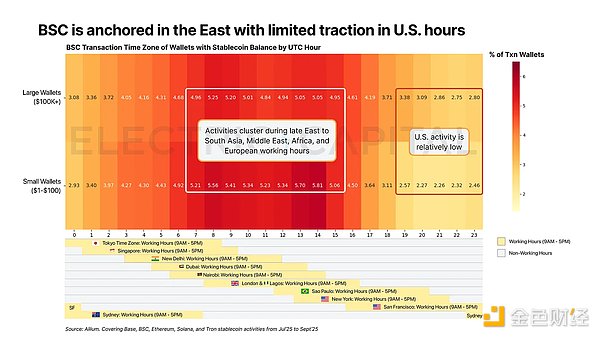
*[Image: PJuivtrEZqsLhBnt0qD53ONvzzsTmVKXqxbCmrHs.png]*
- **Large & Small Wallets**: Both cluster between 7:00 UTC and 15:00 UTC, covering working hours from the Far East to South Asia, the Middle East, Africa, and Europe. Peaks occur at 8:00 UTC (London market open) and 13:00 UTC (U.S. East Coast market open).
- **Regional Preference**: U.S. activity is relatively low after 15:00 UTC, while Asia shows a stronger presence (starting around 2:00 UTC).
### Tron
Tron usage is highly regionally anchored, especially for large wallets.
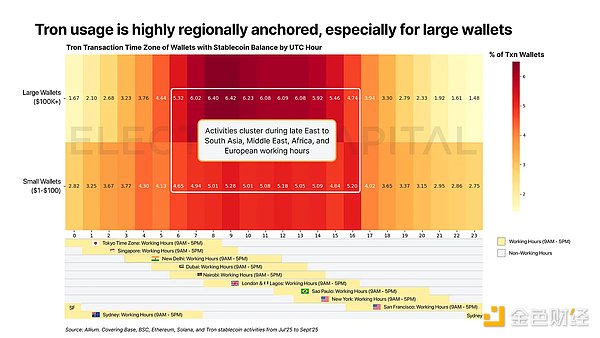
*[Image: Qi2Fe7PkH8p1Zwskwjxp0SNeHlZZqszsXDRXkdaw.png]*
- **Large & Small Wallets**: Both show dense concentration between 6:00 UTC and 16:00 UTC, aligning with working hours from the Far East to South Asia, the Middle East, Africa, and Europe.
Tron has the most concentrated large-wallet activity among all chains.
## Scope & Methodology
- **Chains**: Ethereum, Base, BSC, Tron, Solana
- **Time Period**: July–September 2025
- **Transaction Types**: The analysis covers transfer transactions involving 33 major fiat-backed and non-fiat-backed stablecoins, including USDT, USDC, USDe, DAI, USDS, FDUSD, USD₀, crvUSD, FRAX, USDX, USR, USDZ, TUSD, PYUSD, BUSD, MIM, M, EURC, XSGD, USDP, DEUSD, USDG, USDD, GHO, DOLA, USDA, GYEN, GUSD, EURS, USDM, and RLUSD.
A small number of known contract or test addresses were excluded to reduce noise and ensure only genuine wallet activity is counted.
- **Wallet Filters**: We used each wallet’s stablecoin balance at the start of the month as a proxy for its size. Wallets with a balance of less than $1 at the start of the month were excluded from that month’s analysis.
- **Methodology**:
1. To measure users’ most active times, we counted the number of hours each wallet was active per month.
2. If a wallet made multiple transfers in the same UTC hour across two of the three months, it was counted twice.
3. If a wallet made multiple transfers in the same hour within a single month, it was counted only once for that month.
4. When aggregating cross-chain activity (e.g., all wallets or large vs. small wallets), duplicates across EVM-compatible networks (Ethereum, Base, BSC, and Tron) were removed to ensure each wallet was counted only once.
## Disclaimer
The views expressed in this article are solely those of the authors and do not constitute investment advice for this platform. This platform makes no warranty regarding the accuracy, completeness, originality, or timeliness of the information in the article, nor does it assume any responsibility for any losses arising from the use of or reliance on the information contained herein.
Contact: Sarah
Phone: +1 6269975768
Tel: +1 6269975768
Email: xttrader777@gmail.com
Add: Lee Garden One, 33 Hysan Avenue, Causeway Bay, Hong Kong.